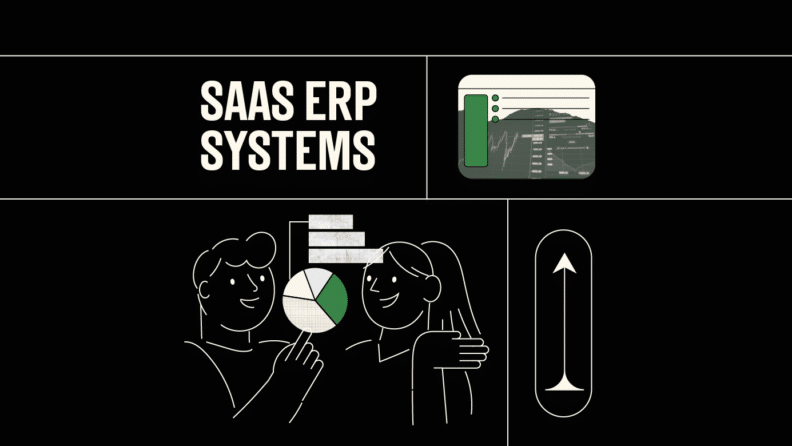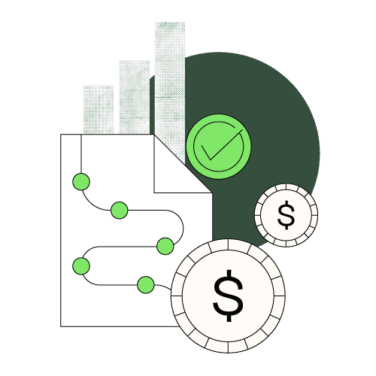SaaS ERP is an enterprise resource planning system that the vendor hosts on their servers and gives you access to in exchange for a fee.
In the current market, ERP solutions are going to be offered via these means more often than anything else.
What is ERP?
Enterprise resource planning systems are technological solutions that allow businesses to manage many of their business processes from one central place.
It gives real-time insight into how your business's central functions are performing, allowing you to strategize and allocate resources effectively.
Common business units covered by ERP platforms include:
What is SaaS?
Software-as-a-service, aka SaaS, is the business model wherein companies pay a vendor for access to their system in exchange for a mutually agreed-upon fee.
If you have a Netflix subscription, you're already using SaaS in your daily life.
The History of SaaS
It used to be that you had to buy hard copies of software and install them locally. If you wanted to update the software, you had to pay for the newest version and go through the process all over again.
With cloud-based solutions, you always have access to the latest version of the software.
A cloud service hosts the software, eliminating the need for business owners to buy new servers or hire extra IT employees to install and maintain everything.
SaaS takes it a step further by combining cloud computing with a subscription model. Instead of paying for each version of a software package, you pay a monthly, quarterly, or annual subscription fee.
Is SaaS ERP Different from Cloud ERP?
If it walks like a duck, looks like a duck, and quacks like a duck, it’s a duck. It's just a different type of duck.
There are differences between SaaS ERP and cloud ERP systems, but they mostly boil down to the level of customization you'll get (and the price difference you'll see to get that customization).
Most tech professionals use the terms SaaS and cloud interchangeably, so I’ll also use SaaS and cloud to refer to the same type of ERP software.
What is On-Premises ERP?
On-premises ERP refers to an ERP system that’s locally hosted within your firm’s tech infrastructure. It's the type of software I mentioned earlier, which has to be updated manually.
On-premises was the default delivery method of ERP systems for a long time, as many companies switched to it before cloud-based ERP was around.
5 Reasons Cloud Beats On-Premises
If you don't process sensitive user data - such as personal health information - chances are good that a SaaS ERP product will be better for you.
If you're on the fence at all, here are 5 reasons I believe SaaS ERP to be superior:
1. Lower Upfront Costs
With on-premises solutions, you have to pay for the software solution, servers, and other equipment upfront. This could create prohibitively high costs arbitrarily.
While you'll perpetually be paying for access to the ERP product, you'll likely still pay less over the long run than you would with an on-prem solution.
2. Quicker Updates
The days of running to the store to get a copy of the newest update are over.. because we have the internet. Instead of missing out or having to pay for each update, your software subscription ensures you're always up to date on the newest features.
3. Greater Accessibility
On-premises solutions reside on local machines, so you have to be at the office to use them, meaning no remote workers and no access to your ERP system when you're on the move.
Cloud ERP software eliminates this problem, giving you access anywhere you have an internet connection.
4. Easier Implementation
Considering you don’t have to purchase new equipment, hire new employees, or install software on local machines, it’s much easier to implement a cloud-based ERP system.
5. Increased Flexibility
With an on-premises solution, you’re limited by your server capacity and the number of licenses you have... but there's no need for that.
Cloud ERP solutions make it easy to add new software features and scale your access up or down according to your business's current needs, making it much more preferable for rapidly scaling companies.
Embrace SaaS ERP For Your Business
Whether you’re an expert ERP user or you don’t know your ERPs from your ABCs, it’s clear that cloud-based systems offer many advantages over on-premises ones.
So what are you waiting for?
Ready to compound your abilities as a finance leader? Subscribe to our newsletter for expert advice, guides, and insights from finance leaders shaping the tech industry.


